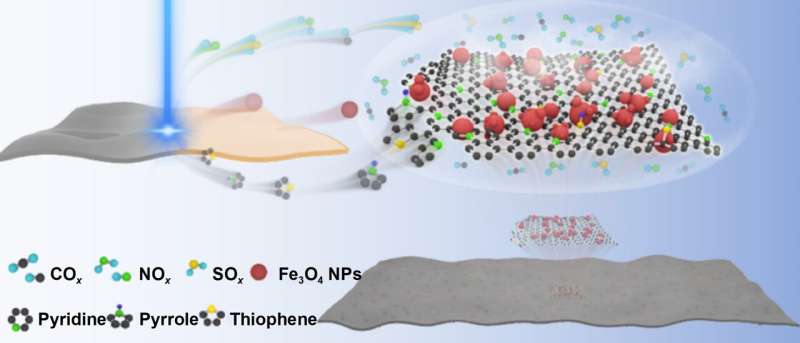This article has been reviewed according to Science X's editorial process and policies. Editors have highlighted the following attributes while ensuring the content's credibility:
fact-checked
proofread
Scientists presents a one-step laser synthesis method for fabricating wideband microwave absorption metamaterial

Scientists from Chinese Academy of Sciences Ningbo Institute of Materials Technology and Engineering, National Physical Laboratory (U.K.), The University of Manchester (U.K.) and National University of Singapore have developed a new approach, published in International Journal of Extreme Manufacturing, to fabricate a specifically designed wideband microwave absorption metamaterial with well-controlled electrical and magnetic characteristics on a polyethylene terephthalate (PET) substrate using ultraviolet (UV) laser irradiation.
The process involves using a UV laser to precisely control the characteristics of 2D pattern on a specially formulated donor material which upon interactions with the laser beam forms magnetic particle imbedded graphene, resulting in a highly functional ultra-wideband (1.56–18.3GHz) and wide angle microwave absorption metamaterial, which could potentially be applied in automatic and roll-to-roll mass production.
This research presents a one-step laser synthesis method that enables spontaneous conversion of PBI ink to 3D nanostructured graphene and the reduction of a liquid ion precursor to Fe3O4 magnetic nanoparticles. Moreover, some of these resulting unique structural features exhibited superior absorption performance compared to most of the MMAs reported previously, and the process, carried out in ambient atmosphere, only requires donor coating and laser irradiation without the need for post-treatment.
"The precise sheet resistance control of laser induced graphene(LIG) with only 5% deviation was achieved by appropriate laser photoreaction and thermal reactions, rather than fixed crystal length of LIG with uncontrollable sheet resistance. Magnetic Fe3O4 nanoparticles were formed using a precisely controlled laser-induced photo-thermal reaction, rather than an oxidized nano-mixture," said Dr. Yihe Huang, the first author of this article and Associate Researcher from Ningbo Institute of Industrial Technology (NIMTE), Chinese Academy of Sciences.
"The laser-controlled fabrication process resulted in a flat surface laminate, with even distribution of magnetic and electric materials. As a result, the measured results of the microwave absorber closely matched the original design."
"Through the employment of a sandwich structure, we have crafted advanced multilayer absorbers that match air impedance over the broadest possible operating frequency range, while upholding a small relative thickness. The first layer, featuring a softly contoured circular pattern, contributes to an extension in the operating frequency. The integration of circular and square patterns in the multilayer structure attains negative permittivity metamaterial properties, achieving a noteworthy perfect absorption (absorptivity of 99%) more than once within the operating frequency range," said Mr. Yize Li, Ph.D. Candidate at the University of Manchester.
The conductive laminates that were fabricated by laser technique show remarkably uniform sheet resistance distribution. The sheet resistance variation is nearly an order of magnitude less than that of screen or spray printing. This advantage helped the final performance of the laser fabricated microwave absorber match its original design.
Dr. Kewen Pan, Associate Researcher at NIMTE said, "After suitable tuning, the microwave absorber achieved an average absorption coefficient in the range of 97.2% to 97.7% over a wide bandwidth and range of incident angles. Based on my literature search, this microwave absorber has the best bandwidth to thickness ratio ever reported."
Professor Lin Li, Director of Laser Extreme Manufacturing at NIMTE and fellow of the Royal Academy of Engineering, commented, "This research has achieved a major breakthrough in the direct production of conformal microwave absorber on complex structures, which was made possible by the simultaneous formation and tuning of electrical and magnetic properties of laser patterned materials on flexible and curved substrates.
"With the highest relative bandwidth and lowest thickness materials till date, this method introduces a new avenue for the large-scale manufacturing of metamaterials for microwave absorption applications in aviation, electromagnetic interference (EMI) suppression, and 5G technology."
More information: Yihe Huang et al, A direct laser-synthesized magnetic metamaterial for low-frequency wideband passive microwave absorption, International Journal of Extreme Manufacturing (2023). DOI: 10.1088/2631-7990/acdb0c
Provided by International Journal of Extreme Manufacturing




















